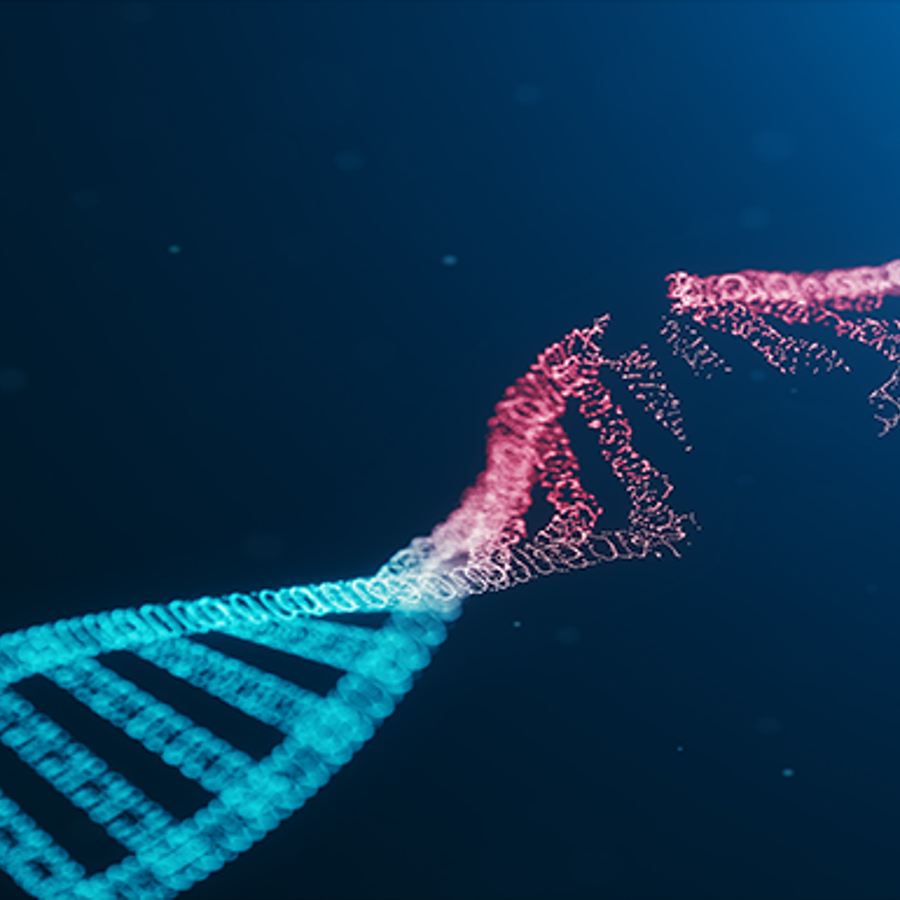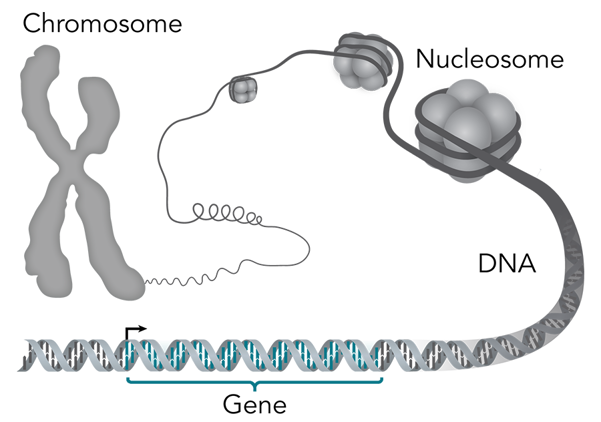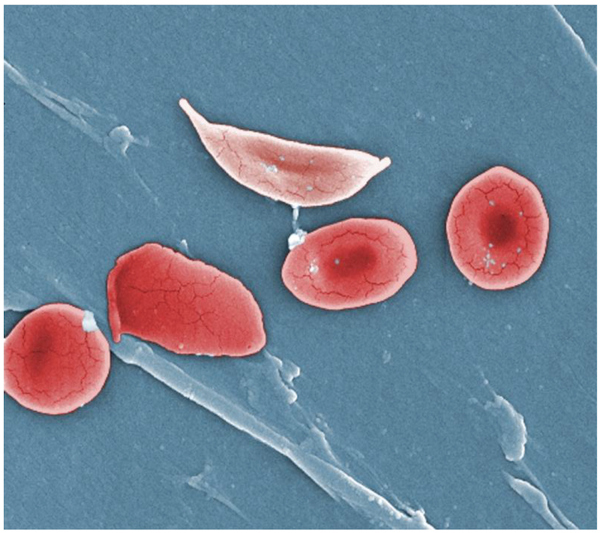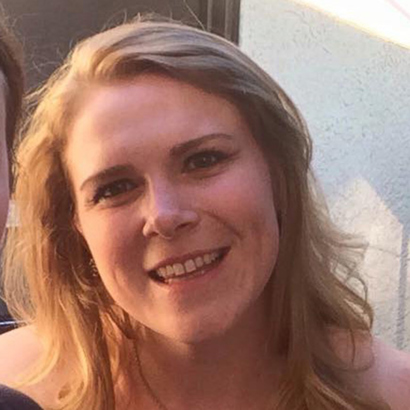
How does a mutation in DNA cause a disease like sickle cell anemia?
August 16, 2016

- Related Topics:
- Genetic conditions,
- Genetic variation,
- Mutation
A high school student from New Jersey asks:
"How does a mutation in DNA cause a disease like sickle cell anemia?"
To many people the word “mutation” sounds scary or magical. They might think of giant ants attacking Tokyo or the X-men.
It turns out that a mutation isn’t really any of these. It is simply a change in DNA. That’s it.To make it even more confusing, the word “mutation” is often used to describe a DNA difference that you inherited. The original change might have happened in your distant ancestor!
And they aren’t even all that rare. Mutations happen all the time and you have lots of them.
While not all mutations cause problems, some do. One of these is the DNA change that can lead to sickle cell anemia.
To understand how a change in your DNA can lead to sickle cell anemia we need to take a step back and talk about genes and proteins. A DNA difference can affect both.
A “Mutation” is Just a Change in Your DNA
Your DNA has the instructions for making you. Your eye and hair color, the shape of your nose, how well you digest milk, and so on, are all right there in your DNA.
These instructions are written in a simple alphabet with just four letters (instead of 26)—
A, T, C, G. All life on the planet comes from these four letters!
For the most part, the instructions for all of the different parts of you are found in “genes.” Each gene has the instructions for one small part of you.

There is a gene that lets some people be able to drink milk, another that decides whether or not you’ll be a redhead, and so on.
And sometimes it takes more than one gene to determine a part of you. For example, eye color comes from many genes all working together.
The way the information in a gene becomes a trait like red hair is through something called a protein. Each gene has the instructions for a specific protein that does a specific job in the cell.
A “mutation” changes the instructions of a gene, which can also change the protein. Sometimes this change makes it so the protein can’t do its job as well.
And this is what happens with sickle cell anemia. A difference in the hemoglobin gene changes the hemoglobin protein in a way that causes sickle cell anemia.
A Difference in the Hemoglobin Gene Causes Sickle Cell Anemia
As I said, a difference in the hemoglobin gene causes sickle cell anemia. And what a tiny difference!
People with sickle cell anemia have a difference in the hemoglobin that changes a GAG to a GTG. Sounds harmless enough, but single letter changes can have a big effect.
Look at this recipe for instance:
“Add the HAM to the soup”
Now imagine we change the “H” in ham to “Y” like so:
“Add the YAM to the soup”
Just a single letter change and you have a very different soup! This is sort of what happens with the hemoglobin gene.
The hemoglobin protein sits in red blood cells where one of its jobs is to take oxygen to every part of your body. It is also responsible for carting away carbon dioxide.
The mutant protein can still do both of these jobs. But that single letter change causes problems with the shape of the red blood cell it is sitting in.
Normally hemoglobin can load up on oxygen and keep its shape. This lets red blood cells move easily through your blood.
The single change in the hemoglobin gene changes what happens to the protein after it picks up oxygen. When it is loaded up with oxygen, it squishes red blood cells into rigid “canoes” that get stuck in small blood vessels.
These sickle shaped cells block blood flow and keep oxygen from reaching parts of your body.

Although there currently is no cure for sickle cell anemia, treatments can relieve pain and help prevent further complications. Click here to learn more about how gene mutations affect health and development.
Not All Mutations are Bad
Sickle cell anemia makes it sound like mutations are bad things! But they don’t have to be.
In fact, people that have the hemoglobin difference that causes sickle cell anemia, but who do not have the disease, actually have some resistance to malaria! And this isn’t the only “good” mutation out there.
This great article talks about three others that actually benefit humans. They are ones that:
- Lower the risk of heart disease
- Increase bone density to make bones stronger
- Make some women able to see more colors
Mutations Make Genetic Diversity
What’s even more amazing is that mutations are absolutely essential for life. They are where all the wonderful differences between you and me and between you and a tuna or a daisy come from. Without them life could not have started and it would not have survived.
You see, mutations are the reason why plants and animals (including people!) can adapt to a changing environment. Let’s look to moths as an example.
Back in the early 1800’s, white-bodied peppered moths were everywhere in Britain (left, bottom). Most likely this was because they could hide from birds on the white trees that were common then (right).

After the Industrial Revolution, however, soot from factories polluted the air and turned tree bark black. Now white moths were sitting ducks for predators.
Luckily, a random mutation had turned a few moths much darker. These moths, which were gobbled up easily before factories started belching smoke, were now protected on the blackened trees. These moths could adapt to a new situation because of a mutation!
Click here for the full story on mutations in peppered moths.
So, in summary, you’ve learned that mutations are just a change in your DNA. Some can be useful and others harmful.
What we didn’t have time to talk about is the fact that these mutations usually don’t do much of anything. They are neutral, neither good nor bad.
And, maybe most importantly, we learned that mutations are critical for generating the diversity of life on Earth today.

Author: Dr. Lauren Liddell
When this answer was published in 2016, Lauren was a postdoctoral fellow in the Department of Genetics, studying how coral genetically responds to climate change in John Pringle’s laboratory. Lauren wrote this answer while participating in the Stanford at The Tech program.
 Skip Navigation
Skip Navigation
